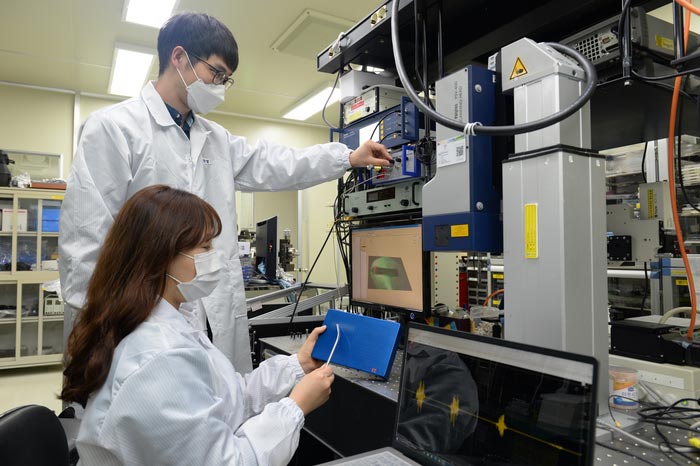ETRI accelerates tactile communication with skin-attached telehaptics

The research team of ETRI demonstrates an experiment of tactile sensations using a sensor.
Credit: Electronics and Telecommunications Research Institute(ETRI)
Telehaptics, which deliver remote and virtual tactile sensations, increase immersion by attaching them to fingers. Place a 1mm micro haptic device on an ultra-thin flexible substrate 1/20 of a human hair.
Electronics and Telecommunications Research Institute (ETRI) has developed a telehaptic device that remotely transmits tactile sensations in real time by attaching it to the fingertip like a sticker. It is expected to add a sense of immersion to the metaverse and real tactile experience with world-class performance and usability through ultra-miniaturization.
Electronics and Telecommunications Research Institute (ETRI) announced that it has developed a skin-attached telehaptic technology that solves the immersion hindrance of existing tactile reproduction devices and provides a more vivid tactile experience by closely contacting the skin.
This technology was published in NPJ Flexible Electronics, the world’s most prestigious journal in the field of electronic engineering.
This technology uses the unique vibration pattern of touch and texture. Through tactile collection sensors and tactile reproduction actuators, people can feel textures virtually without touching objects in reality.
Following the disclosure of telehaptic technology in April of last year, ETRI succeeded in advancing the technology into a form that can be adhered to the finger like a sticker.
It solved the large volume and low performance of existing tactile reproduction devices. For a highly immersive user experience, precise tactile and texture reproduction that is thin enough to be attached to the skin is essential.
The research team used a self-developed piezoelectric element and an ultra-thin flexible substrate to precisely integrate microscopic sensors and actuators of less than 1mm on the substrate. The substrate is thin and bendable with a thickness of 1/20 of a human hair (about 4㎛), so it is suitable for attaching to the skin.
The high-resolution composite sensor, which is finely structured at 1.8 mm intervals, can feel tactile patterns in a wide frequency range of 1 ~ 1,000 hertz (Hz). It demonstrated world-class performance by simultaneously measuring both slow-changing pressure (static pressure) and fast-changing pressure (dynamic pressure).
In particular, this achievement can measure and reproduce materials such as cotton, polyester, and spandex, as well as the shape of convexly protruding letter surfaces and the dynamic feeling of plastic rods rolling on the fingertips. This is because the high-resolution sensor recognizes even minutely different tactile patterns for each location.
The skin-attached telehaptic technology developed by ETRI can reproduce tactile sensations in real time at a distance of up to 15m using Bluetooth communication. In particular, the delay time when transmitting the tactile/texture data signal was only 1.55 milliseconds (ms), and the acquired and reproduced signals matched approximately 97%. This eliminates any awkwardness in signal transmission.
The research team said this technology is the result of integrating ▲ ultra-thin highly flexible substrates ▲ static/dynamic high-resolution composite pressure sensors ▲ high-power ultra-small piezoelectric actuators ▲ signal processing and driving of piezoelectric sensor/actuator ▲ composite tactile/texture data control and wireless communication linkage technology.
Principle Researcher Hye Jin Kim of ETRI’s Intelligent Sensors Research Section said, “Through the light and flexible on-skin tactile reproduction device that can be attached to the skin, we have taken a step forward in preparing a foundation environment for developing highly immersive virtual/augmented reality content.”
The research team said that, in the future, they plan to innovatively advance the performance and form factor of the piezoelectric element to create complex tactile and texture levels that match reality by combining not only vibration but also various tactile stimuli.
In addition, they plan to implement more realistic complex sensors and actuators by further upgrading the design of piezoelectric elements and structures to increase output performance and add heat and cold sensations.
This research was carried out with “Development of high piezoelectric coefficient composite and ultra-low power multilayered piezoelectric sensor/actuator multi-functional module technology” of the Ministry of Science and ICT.
Journal: npj Flexible Electronics
DOI: 10.1038/s41528-022-00216-1
Article Title: Highly pixelated, untethered tactile interfaces for an ultra-flexible on-skin telehaptic system
Article Publication Date: 8-Sep-2022
All latest news from the category: Information Technology
Here you can find a summary of innovations in the fields of information and data processing and up-to-date developments on IT equipment and hardware.
This area covers topics such as IT services, IT architectures, IT management and telecommunications.
Newest articles

Innovative 3D printed scaffolds offer new hope for bone healing
Researchers at the Institute for Bioengineering of Catalonia have developed novel 3D printed PLA-CaP scaffolds that promote blood vessel formation, ensuring better healing and regeneration of bone tissue. Bone is…

The surprising role of gut infection in Alzheimer’s disease
ASU- and Banner Alzheimer’s Institute-led study implicates link between a common virus and the disease, which travels from the gut to the brain and may be a target for antiviral…

Molecular gardening: New enzymes discovered for protein modification pruning
How deubiquitinases USP53 and USP54 cleave long polyubiquitin chains and how the former is linked to liver disease in children. Deubiquitinases (DUBs) are enzymes used by cells to trim protein…



